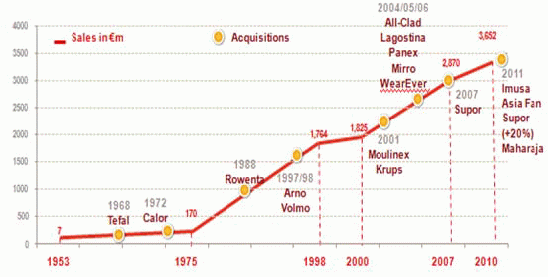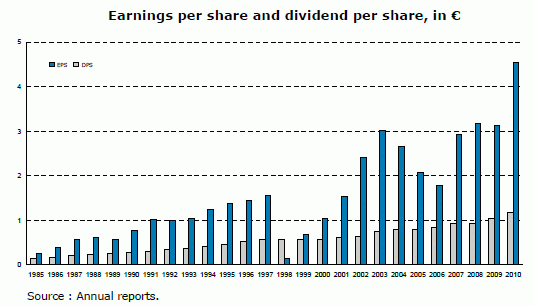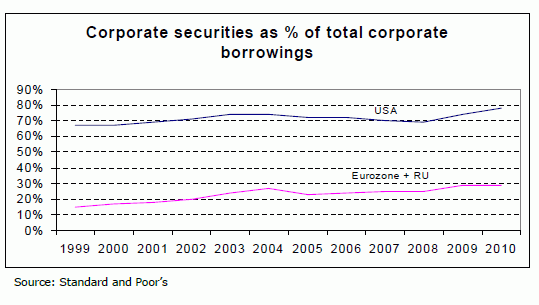Letter number 65 of February 2012
ALL ARTICLES
- TOPIC
- STATISTICS
- RESEARCH
- QUESTIONS & COMMENTS
News : A fine example of financial policy: SEB
As we explained in a new chapter of the Vernimmen created in the 2011 edition, Finance and Strategy, a firm’s financial policy must take into account:
• the macro-economic environment;
• the firm’s general strategy;
• and the shareholder base.
SEB, the international leader in domestic electric appliances (6 products sold per second worldwide, 250 new products launched every year, €3,965m in sales in 2011), seemed to us to be a fine example of what a good CFO should do to contribute, day after day, to the development and success of the firm.
SEB was founded in 1857 by the Lescure family, which listed the group in 1975 and which currently holds 44% of the shares, 57% of the voting rights and 10 out of 15 seats on the Board of Directors.
This family seems to act less like the owner of its shares than like the depositary of these assets, keeping them safe for the next generation, a bit like in the Patek Philippe advertisement (1).
Given this frame of mind, the reader will not be surprised that the most outstanding feature of the group’s financial policy is caution. Over the last 10 years, the Debt / EBITDA ratio has never exceeded 2 times. Similarly, since 1985 (2), the dividend per share has never been reduced, which means that the average payout rate is low in order to enable the company to finance itself more generally and also to avoid reducing the dividend per share in the event of a severe crisis like in 1998 and 1999 (the Russian crisis). The following graph, which is one of the new graphs created for the 2011 edition of the Vernimmen, provides an illustration:
When the family block is made up of around 260 members, only one of whom works for the company, it is wise to pay special attention to the dividends policy – for some family shareholders, the dividend accounts for a large share of their revenues. The flip-side of shareholder loyalty is consistency in the dividend payout policy – the dividend has never been reduced and has risen by an average of 8.3% per year.
The firm’s general strategy is the second determining factor of financial policy. SEB operates in a sector where capital intensity is low. The ratio between sales and capital employed is around 1.7 and annual investments are around €120m, representing 30% of cash flow. In fact, some spending is recorded on the income statement - R&D (2% of sales) and advertising (3 to 4%, which is as much as standard capital expenditures).
In this sector, SEB has expanded through organic growth, based on geographic expansion (present in 150 countries) and product innovation (from the super pressure cooker to the Actifry fryer), but also to a large extent, through external growth. Of the 21 brands that the group owns, only one was developed inhouse (SEB). All of the rest (Moulinex, Tefal, Krups, Calor, Lagostina, Supor, Rowenta, etc.) were acquired, and half of them since 2001.
In other words, the financial policy of SEB must ensure that there are large cash reserves, that can be mobilised at any time, because in the matter of external growth, it is wise to heed the words of Saint Matthew and “Watch ye therefore, for ye know not the day nor the hour” that a given target will become available.
SEB only has net bank and financial debt of €251m on June 30, 2011 and its long term resources, drawn down or not, are €1.2bn in 2011, which only fall (due to long-term reimbursements) to €900m in 2015. That’s enough money to do a bit of shopping!
Which also means that the group bears a cost for this flexibility since the long-term resources drawn-down (€537m on June 30, 2011), not used to finance capital employed (€475m on the same date) and thus booked as cash do not, in the current context, earn the same interest rate as they cost. But like any insurance policy, flexibility has a financial cost.
In terms of financing, SEB has stuck firmly to four principles over the last few years:
• diversify sources of financing;
• extend the maturity of financing;
• maintain close relationships with a limited number of bankers;
• put in place legal documentation that is as flexible and the least restrictive as possible.
Diversifying sources of finance, means complementing existing sources of financing with banks and the commercial paper market by tapping the listed bond market (€300m over 5 years placed in May 2011) and the private bond market (issue in 2008 of €161m in so-called Schuldschein (3) bonds, maturing in 2013 and 2015, subscribed by German investors).
Extending the maturity of financing mainly means heavily reducing the share of commercial paper, resources which are by definition short term (4). Reducing them does not mean cutting them out all together. The €600m programme was never stopped so that investors on this market got the unpleasant impression that SEB only called on them when it needed them and was unable to secure resources elsewhere.
Maintaining a close relationship with a limited number of banks in order to secure their commitment to supporting the group, including during difficult times, meant reducing the number of banks involved in its syndicated loan from 40 to 9 when it was renewed in 2004, and then 7 in 2006 and 2011. These banks, in exchange for taking a higher risk, achieved a larger market share of side business, which improved their earnings on the credit activity – cash management, foreign exchange, hedging, employee saving plans, etc.
The drawback of this sort of practice is that if one of the banks disappears (bankruptcy, buyout, merger), which is always possible in the current environment, a medium-term financing need will arise. But doubtless, given the company’s superior reputation, there would be more than a few lending establishments queuing up to take the place of the one that has gone out of business.
With regard to the flexible and least restrictive as possible legal documentation, SEB’s main challenge was to get rid of its covenants (5), which it managed to do in 2006. This was more as a matter of principle than anything else. The low level of risk of its activity and its low level of debt, explain this situation.
Obviously, having an intelligent financial policy is a lot easier when the company is performing well operationally and its debt level is low. Limiting the number of banks, concentrating debt on long-term loans with uncomplicated bank documents, becomes a lot trickier for groups that are heavily indebted. Having said that, it’s when business is ticking over nicely that it is important to be rigorous and demanding, because when the situation deteriorates, it’s often too late to do things properly.
Similarly, diversification of sources of financing is more complicated for smaller groups – no access to the bond market or even to commercial paper. But other sources of financing remain available (factoring, leasing). The diversification of sources of financing is not without cost. Management can be complex and there may even be a liquidity discount if market products are issued in volumes that are too low. Accordingly, a balance has to be found, and it looks as though SEB has found it.
* * *
The reader will now understand that SEB’s financial policy is exemplary in the way in which it corresponds to its industrial environment and shareholder base. Here at the Vernimmen, we don’t give out prizes, but if we did, the SEB Financial Management Department, whose maxim is “Sale is vanity, profit is sanity, cash is reality”, would be a serious contender for one.
(1) “You never actually own a Patek Philippe. Your merely look after it for the next generation.”
(2) We didn’t go further back.
(3) For more information, see chapter 22 of the Vernimmen.
(4) For more information, see chapter 22 of the Vernimmen.
(5) For more information, see chapter 34 of the Vernimmen.
Statistics : Corporate securities as % of total corporate borrowings
The US and European situations are far apart in this field due to history. The US bond market was created around 150 years ago whereas it is only 13 years old in Europe. The very fragmented US bank market with a track record of regular bankruptcies, has disincentivised the US CFO from relying too much on a house bank and pushed him/her toward the bond market.
Basle III is certainly going to change all that over the coming years, with European companies relying more and more on the bond market to raise debt and less and less on banks. This is already the case for very large groups like Siemens, Sanofi or BAE and will increasingly affect smaller groups in the future.
Research : CFO versus CEO Equity incentives
The separation between ownership and control in major listed groups has led to the development, over several years, of academic research into incentives. The manager’s contract (in particular his/her compensation) must incentivize him/her to act in the interests of shareholders. In order to flesh out the theoretical models, a large number of empirical studies have looked at the consequences of these contracts on concrete decisions made by management.
This month we present a study (1) which falls into this field of research, and which makes an original contribution – in addition to the Chief Executive Officer (CEO), Chava and Purnanandam also look at the Chief Financial Officer (CFO). Their study shows that the CEO takes the major decisions in terms of financing (financial leverage, liquidities) while the CFO takes the more technical decisions (debt maturity, profit spreading).
Chava and Purnanandam have come up with two incentive indicators for managers, delta and vega. The delta measures the sensitivity of the manager’s wealth to the price of the share. This is the standard effect of performance related pay. As the CEO/CFO is unable to diversify his/her assets in the same way as a shareholder, a high delta creates an incentive to reduce the risk (in particular the risk that is specific to the firm, that is not remunerated). The vega represents the sensitivity of the manager’s wealth to the volatility of the share. For example, vega is higher if the manager has stock options. All other things being equal, a high vega creates an incentive to increase the risk.
This empirical analysis is based on a large sample of US firms between 1993 and 2005. Chava and Purnanandam paid special attention to the robustness of their results, taking standard explanatory criteria of modes of financing into account (2). The results are as follows:
1.Financial leverage (3). A high delta for the CEO significantly reduces financial leverage, while a high vega increases it. This ties in with the fact that a high financial leverage increases the risk of the share. Incentives for the CFO, however, have no statistically significant impact.
2. Available cash. Previous studies have shown that a high level of available cash could lead to a reduction in risk. The results are similar to financial leverage for the CEO – greater liquidity (so less risk) with a high delta, lower liquidity with a high vega. The results are significant and are similar for the CFO, although the impact of incentives on the CEO is around twice as much.
3. Debt maturity (4). Shorter term debt increases the risk related to refinancing and the variability of interest rates. This time it is the CEO incentives that are not statistically significant. For the CFO, a high delta results in a longer maturity period (lower risk), and a high vega in a shorter maturity period.
4. Spreading of profits. By using the adjustment accounts (5), managers can reduce the volatility of profits on the balance sheet with the hope of reducing the volatility of the share. For both the CEO and the CFO, a high delta will result in more spreading of profits and a high vega less. The impact is slightly higher for the CFO.
For the first time, a very large empirical study has shown that the incentivizing contracts of CEOs AND CFOs has consequences for the firm’s financing policy. These results should be taken into account when compensation packages for top level management are put in place.
(1) S.Chava and A.Purnanandam (2010), CEOs versus CFOs: Incentives and corporate policies, Journal of Financiel Economics, vol.97, pages 263-278.
(2) These were size, profitability, nature of assets and financial health of the firm.
(3) Defined as book leverage (total debt / book value of assets); other definitions lead to similar results.
(4) Here, Chava and Purnanandam divided the debt into short-term debt (less than 3 years) and long-term debt (more than 3 years).
(5) For a description of adjustment accounts, see chapter 6 of the Vernimmen.
Q&A : The European project for a Financial Transaction Tax
In September 2011, a draft EU Directive was introduced, initiating a Europe-wide tax on financial transactions to which a financial institution is party, either for its own account or for that of its clients. The aim is to get the financial sector to pay for part of the costs brought about by the current crisis, to discourage certain types of transactions such as high frequency trading, and to co-ordinate, at a European level, domestic initiatives that are likely to hamper the functioning of the common market, if every country introduces its own initiative.
For its part, the French government has just filed draft legislation that could be applied as early as August 2012, explaining that it wishes to be an example in
Europe and to encourage other countries to follow suit by introducing this tax as quickly as possible. The French tax is rather different from the draft EU Directive, with a smaller scope which should have little impact on financial institutions.
What are the consequences that this draft European legislation could have for companies?
1/ Transactions involving shares
Firstly, it should be noted that primary issues (capital increases, issues of new bonds) are explicitly excluded from the scope of this taxation since Directive 2008/7 CE forbids the taxation of primary operations.
As regards secondary transactions, the EU project targets bonds, derivatives, etc. in addition to shares, whether listed or not, regardless of the size of the issuer. It will apply to securities bought or sold, regardless of their nationality, by a financial institution located in the European Union, for its own account or on behalf of a client.
2/ Transactions involving UCITS
Carried out by companies, they can, under the draft EU Directive, be taxed at a minimum of 0.1% since UCITS are specifically not excluded from the scope of the tax. The UCITS cannot pay this tax themselves as that would mean penalising the other holders of units every time a buyback or a subscription is registered.
Moreover, their net assets would be penalised by higher transaction costs since they would have to pay tax on their transactions involving securities that have been taxed, which, one way or another, will be passed on to them.
It has also been mentioned, although the draft Directive does not take this into account, that given the low returns on monetary UCITS, they could completely escape the scope of taxation for their investments and the transactions involving their units.
3/ Foreign exchange transactions
Spot transactions are exempt from tax under the draft EU Directive, so as not to obstruct the free flow of capital. On the other hand, transactions of all types (hedging, arbitrage, speculation), that involve foreign exchange or other derivatives (options, forwards, futures) will be taxed at a minimum rate of 0.01% if financial institutions (in the broad sense of the term, including clearing houses) are involved.
4/ To be exempted from the draft EU Directive, in addition to transactions on the primary market and on the foreign exchange spot market, are payment transactions, loans and credits of companies, households and financial institutions, transactions carried out with central banks and insurance contracts.



